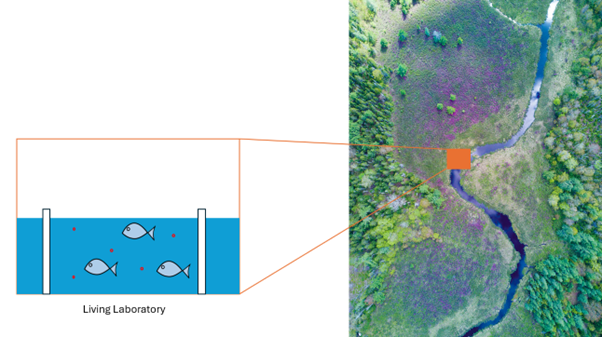The problem…
Waste management issues are escalating with population growth, with marine litter representing a serious environmental concern (Gola et al., 2021). In particular, the breakdown of waste plastics, such as the commonly used polypropylene and polyethylene (Dikareva and Simon, 2019), into microplastics, and its entrance into marine environments through run-off has been noted as a serious concern, adversely impacting marine fauna.
Thorough knowledge of the effect of plastic on environmental health is vital; in 2020, global production of plastic was estimated as being ~ 367 million metric tons (Tiseo, 2021). Of this, up to 12.7 million tons of plastic is disposed of into oceans annually (Jambeck et al., 2015), breaking down into microplastics. Microplastics have been found in a wide variety of marine ecosystems, including coastal regions, deep sea sediments, and polar areas (Bergmann et al., 2015), with distribution depending on size, shape, density, and environmental factors (Duis and Coors, 2016). The bioaccumulation of microplastics within various marine organisms, and biomagnification up the food web, is widespread (Guzzetti et al., 2018) and can result in health issues (Gola et al., 2021), including infertility and internal injuries (Cole et al., 2015). Microplastics also act as vectors for other pollutants, increasing their overall toxicity (Amelia et al., 2021) with oxidative damage and enzyme activity changes having been reported (Oliviera et al., 2013; Luis et al., 2015). Perhaps the most extreme indicator of the impact of microplastics is the effect that they have on organisms on a genetic level (Rochman et al., 2014). All these factors have profound implications for environmental and biological health, as well as the health of consumers of seafood products.
It is therefore obvious that the effects of microplastics have to be understood in as great a depth as possible. Reviewing the literature has suggested that a large amount of this knowledge is based on observational studies, which are not controlled to explore the fine details of the effects of different microplastic factors on ecosystem and species health.
The solution…
We propose building “living laboratories”. This will provide areas where the density, shape, and size of microplastics can be directly controlled. This will allow a direct causal link between microplastics and various aspects of microplastic pollution on marine organisms.
Of particular interest to this team, is the impact that different microplastics concentrations have on the feeding behaviour on fish species. The retention of microplastics within the organs will be monitored using dissections. This also gives the unique opportunity to study the impact of microplastic presence on the behaviour of marine organisms. We plan to complete a longitudinal study observing the impacts of different microplastic concentrations on mating and parental behaviour. This work will inform the impacts of microplastics directly and indirectly on environmental and biological health. In particular, it will allow the elucidation of different permutations of microplastic size, shape, and density.

References
- Amelia, T.S.M.; Khalik, W.M.A.W.M.; Ong, M.C.; Shao, Y.T.; Pan, H.J. and Bhubalan, K. (2021) Marine microplastics as vectors of major ocean pollutants and its hazards to the marine ecosystem and humans, Progress in Earth and Planetary Science, 8, pp.1-26
- Bergmann, M.; Gutow, L. and Klages, M. (2015) Marine anthropogenic litter, Springer Nature
- Chan, H.S.H.; Dingle, C. and Not, C. (2019) Evidence for non-selective ingestion of microplastic in demersal fish, Marine pollution bulletin, 149, p.110523
- Cole, M.; Lindeque, P.; Fileman, E.; Halsband, C. and Galloway, T.S. (2015) The impact of polystyrene microplastics on feeding, function and fecundity in the marine copepod Calanus helgolandicus, Environmental science and technology, 49, pp.1130-1137
- Dikareva, N. and Simon, K.S. (2019) Microplastic pollution in streams spanning an urbanisation gradient, Environmental Pollution, 250, pp. 292-299
- Duis, K. and Coors, A. (2016) Microplastics in the aquatic and terrestrial environment: sources (with a specific focus on personal care products), fate and effects, Environmental Science Europe, 28, pp. 2
- Garcia, T.D.; Cardozo, A.L.; Quirino, B.A.; Yofukuji, K.Y.; Ganassin, M.J.; dos Santos, N.C. and Fugi, R. (2020) Ingestion of microplastic by fish of different feeding habits in urbanized and non-urbanized streams in Southern Brazil, Water, Air, and Soil Pollution, 231, p.434
- Gola, D.; Tyagi, P.K.; Arya, A.; Chauhan, N.; Agarwal, M.; Singh, S.K. and Gola, S. (2021) The impact of microplastics on marine environment: A review, Environmental Nanotechnology, Monitoring & Management, 16, p.100552
- Guzzetti, E.; Sureda, A.; Tejada, S. and Faggio, C. (2018) Microplastic in marine organism: Environmental and toxicological effects, Environmental toxicology and pharmacology, 64, pp.164-171
- Jambeck, J.R.; Geyer, R.; Wilcox, C.; Siegler, T.R.; Perryman, M.; Andrady, A.; Narayan, R. and Law, K.L. (2015) Plastic waste inputs from land into the ocean, Science, 347 , pp. 768-771
- Luís, L.G.; Ferreira, P.; Fonte, E.; Oliveira, M. and Guilhermino, L. (2015) Does the presence of microplastics influence the acute toxicity of chromium (VI) to early juveniles of the common goby (Pomatoschistus microps)? A study with juveniles from two wild estuarine populations, Aquatic Toxicology, 164, pp.163-174
- Oliveira, M.; Ribeiro, A.; Hylland, K. and Guilhermino, L. (2013) Single and combined effects of microplastics and pyrene on juveniles (0+ group) of the common goby Pomatoschistus microps (Teleostei, Gobiidae), Ecological indicators, 34, pp.641-647
- Rochman, C.M.; Kurobe, T.; Flores, I. and Teh, S.J. (2014) Early warning signs of endocrine disruption in adult fish from the ingestion of polyethylene with and without sorbed chemical pollutants from the marine environment, Science of the total environment, 493, pp. 656-661
- Tiseo, I (2021) Annual production of plastics worldwide from 1950 to 2022, Statista